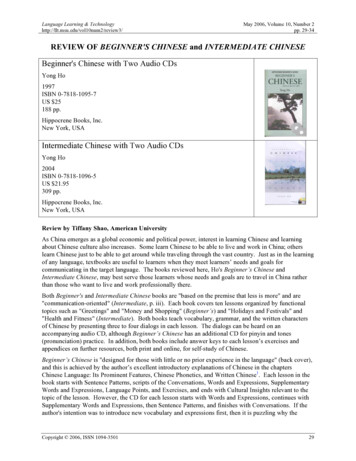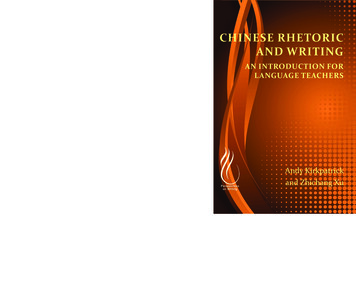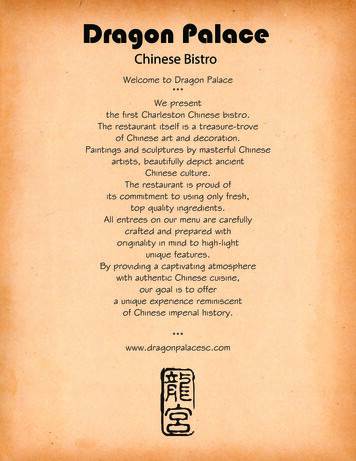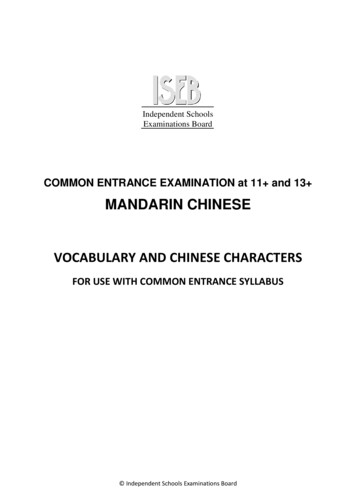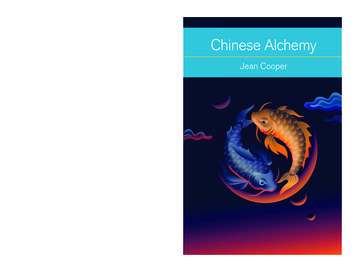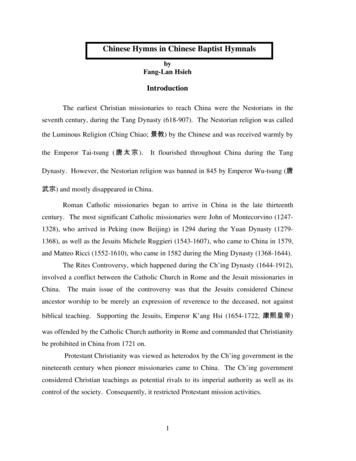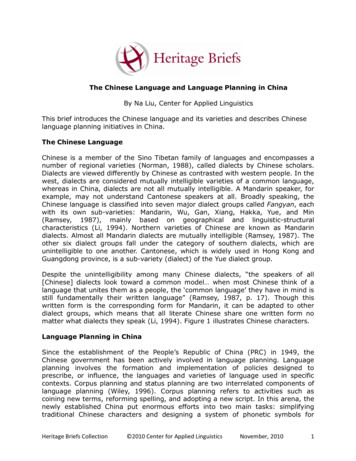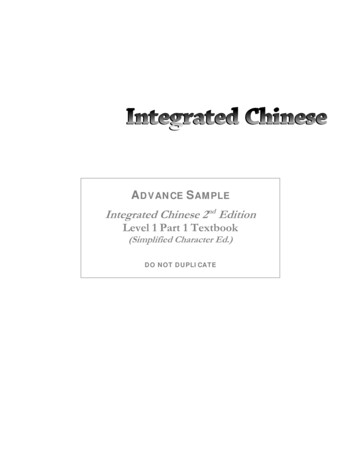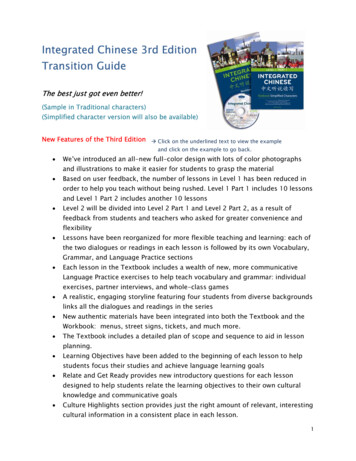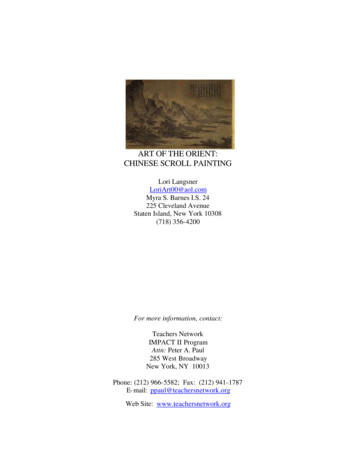
Transcription
ART OF THE ORIENT:CHINESE SCROLL PAINTINGLori LangsnerLoriArt00@aol.comMyra S. Barnes I.S. 24225 Cleveland AvenueStaten Island, New York 10308(718) 356-4200For more information, contact:Teachers NetworkIMPACT II ProgramAttn: Peter A. Paul285 West BroadwayNew York, NY 10013Phone: (212) 966-5582; Fax: (212) 941-1787E- mail: ppaul@teachersnetwork.orgWeb Site: www.teachersnetwork.org
Table of ContentsProgram Outline.2Major Goals and Overview.2Target Students.2Timelines .3Assessments.5Lesson Plans.6Sample Worksheets.8Resources.13Bibliography.14Student Work Samples.15
PROGRAM OUTLINEMajor Goals and OverviewThis is an interdisciplinary program using the social studies curriculum as animpetus to the fine arts lesson. Students study the cultural background of the Orientduring their social studies periods, while working on a Chinese scroll painting in their artclass. During class discussions, students share ideas about important culturalcontributions that the Chinese have made to our society. Through readings and Webresearch, they discover that it is the Chinese who are credited with the invention of thekite and compass, and how meditation and religion greatly influence their art.Students begin with an in-class reading comprehension assignment that introducesthem to the art of scroll painting. They learn that a scroll is a long roll of illustratedparchment that is meant to be hung, or read like a book. Through the use of technology asa research tool, students are now able to view the collection of Chinese art at theMetropolitan Museum of Art in New York City at the click of a button. I highlyrecommend that you visit this site to gain greater insight into the art of scroll /html pages/elegant3.htm)Using the Chinese themes of landscape, flowers, bamboo, dragons, and birds,students begin sketching ideas for their own scroll. They begin to study pictographs andpractice the art of Chinese calligraphy. Using the art mediums of watercolor, and pen andink, students creatively design an original oriental scroll painting illustrating a themebased on nature. Completed painted scrolls are attached to dowels and string to be hungin a classroom gallery.This lesson lends itself easily to many subject areas. Students are given theopportunity to explore Web sites and visit actual museum collections. Through readingand responding to new information, and through analysis and interpretation, students areable to create their own works of art in the authentic Chinese style. They have valuablediscussions and gain insight into the art of the Orient. This lesson touches upon all theNew York City Learning Standards for the Arts: Creating and Participating in the Arts,Knowing and Using Art Materials and Resources, Responding to and Analyzing Worksof Art, and Understanding the Cultural Contributions of the Arts.Target StudentsThis lesson targets sixth- grade major art talent classes. The students meet in theart room four times per week for forty- five minute periods. This program can be easilyadapted to all grade levels. The focus is on reading, doing research, creating artwork, anddeveloping written and oral communication skills. This lends itself to creative thinkersand problem solvers. The hands-on approach offers opportunities for kinesthetic andvisual learners as well.-2-
TimelinesAllowing one month of instruction and execution of this project, I have broken itdown into daily objectives.-Day 1: Students will recognize the important cultural contributions of the Chineseculture in art.Students are asked to silently read a teacher-made historical passage and answerreading comprehension questions (see attached worksheet). This leads to classdiscussion and interpretation of the art of the Orient.-Day 2: Students will review and discuss the importance of Chinese art andculture.Original and student sample scrolls are shown for students to review, analyze, anddiscuss their interpretations of the Oriental art. Students are asked to sketch samplescrolls found in their books or on display in the classroom to get a feel for thecomposition and technique of scroll painting.-Day 3: Students will familiarize themselves with proper ways to utilize searchengines.Using school library visits and homework assignments, students will research Websites on Chinese Scroll Painting and Calligraphy. Using the information they havegathered, students will sketch ideas for their scrolls. I have found the Asian Artcollection of the Metropolitan Museum of Art to be invaluable. The following linksare highly recommended. Please visit these sites: www.metmuseum.org - TheMetropolitan Museum of Art which links to their Asian Art collection, as well as to aspecial exhibition entitled: The Embodied Image: Chinese Calligraphy from the JohnB. Elliot Collection; www.metmuseum.org/explore/chinese/html pages/glossary.htm-Glossary of Chinese painting at the Metropolitan Museum of Art;www.metmuseum.org/explore/chinese/html pages/elegant3.htm -Chinese painting atthe Metropolitan Museum of Art;www.chinapage.org/callig1.html -Examples of Chinese calligraphy.- Day 4: Students will explore the fine art of Chinese calligraphy.Students study pictographic images (see attached worksheets), followed by teacherdemonstration of brushstrokes using ink to create pictographs (symbols used to representwords) and images. The students create their own pictographic studies.-Day 5: Using a theme in nature, students will choose three pictographs fromworksheets to illustrate their theme.They continue to practice the art of calligraphy, using brush and ink.- Day 6: Students will create sketches to illustrate their nature themes.Using the pictographs studied, the students now create a pencil sketch of their scroll. Forexample, students will illustrate a theme in nature using the pictographs for-3-
mountain, water, and rock. They draw these pictographs along with a drawing ofmountains, rocks, and waterfall as their illustration (see attached sample).- Day 7: Students will creatively design an Oriental Scroll Painting.Using 9”x18” white painting or rice paper, students pencil-draw their natural landscapedesigns.- Day 8: Students will use the art medium of watercolor to paint Oriental scrolls.Using a limited palette of soft washes, students are introduced to painting their scrollbackground (students have previously been taught the art of watercolor). Teacherdemonstration and review of watercolor techniques, “wash” and painting “wet on wet”are further explored.-Day 9: Students will explore the art of watercolor as they paint their Orientalscrolls.Students continue at their own pace using their watercolor painting skills.- Day 10: Students will complete watercolor painting their scrolls.Fine detail brushes are applied over washes to bring out features with strong lines.- Day 11: Students will paint pictographs using brush and ink technique.Over dry paintings, students use their Chinese brushstrokes to complement theirpaintings, which are compositionally and aesthetically pleasing to the eye. The threepictographs are usually painted together in a row across the top, or the upper of lowercorners.- Day 12: Students will prepare their scrolls for hanging and display.Using 12” wooden dowels, students roll their scroll over the top and bottom and coverwood with glue. Once dry, they attach a thin cord to the top center of their scroll withstrong clear tape. Completed scrolls are now ready for display in classroom art gallery.-Day 13: Class evaluation and discussion.-Day 14: Class visits to view gallery.-4-
AssessmentsThe assessment tools used for this lesson falls into two categories:1. Student Performance Assessment - where students are judged against a list ofcriteria for this type of work. Art is a very personal subject and difficult tograde. I have based assessment of many lessons on overall criteria includingthe following: How well did the student follow instructions? Did he use histime effectively? Did he reach his goal or my objective? How creative wasthis student in his design? What specifics were utilized as far ascraftsmanship? Overall appearance accounts for most of the grade, as well asthe effort the student applied. Using a grade of 85% as a mid-point, I gradeaccordingly as I see warranted.2. Evaluation Assessment – most effective when students have had time topractice giving constructive feedback. I would spend one period on a classevaluation. I would display all completed artwork on the blackboard at thefront of the classroom. I would then write five evaluation questions on theboard or, at times, ask the questions orally. Giving the students approximatelyhalf the period to record their answers, we would then review and discuss, andcritique one another’s work. The evaluation questions for this lesson can befound in my lesson plan.-5-
LESSON PLANSART OF THE ORIENT: CHINESE SCROLL PAINTINGMrs. L. Langsner, Art TeacherAIM: 1. Students will recognize the achievements and contributions of the Chinese culture in Art.2. Students will creatively design an Oriental Scroll Painting.DO NOW: 1. Silently read pages 68 -70 in Understanding Art by Mittler & Ragans,Glencoe/Macmillan/McGraw-Hill Publishers, 19922. Copy and answer questions 1-6 on p. 69. (If textbook is unavailable, use the reading passageas seen on worksheet.)Q1. Name two inventions credited to the early Chinese.A1. Co mpass, kitesQ2. What religion was introduced to China during the Han dynasty?A2. BuddhismQ3. What is meditation? What has been its role in Chinese art of the last 2000 years?A3. Focusing one’s thoughts on a single object or idea. This experience allows the person to know theinner beauty of the object or idea.Q4. What are scrolls?A4. A long roll of illustrated parchment meant to be hung, or read like a book.Q5. What art flourished during the T’ang dynasty and during the Sung dynasty?A5. Sculpture and landscape painting.Q6. What art form reached its highest point during the Ming dynasty?A6. Porcelain pottery.3. Sketch the scroll painting landscape on p. 70.HOMEWORK: 1. Using search engines, research Web sites on Chinese Scroll Painting and Calligraphy.2. Chinese artists began work only after long meditation. This helped to capture the moodhe wanted to show. Choose an object in your home, sit silently for five minutes, and study the object fromevery angle. Then place the object out of sight, using a paintbrush and one color, draw what you haveperceived.VOCABULARY: 1. Orient - people from Eastern Asia.2. scroll - rolled up paper with words and pictures.3. calligraphy - beautiful handwriting, considered an art form in China.4. pictograph - picture symbols used to describe a word.LINKS: www.metmuseum.org - Metropolitan Museum of Art links to their Asian Art collections as well asto special exhibition - “The Embodied Image”: Chinese Calligraphy from the John B. Elliot /html pages/elegant3.htm – Chinese painting at theMetropolitan Museum of Arthttp://www.metmuseum.org/explore/chinese/html pages/glossary.htm – Glossary of ChinesePaintingGRADE LEVEL: 6th grade art talent classesESTIMATED TIME: One month - class meets 4 times per week for 40 minutesSETTING: Art ClassroomINTERDISCIPLINARY AREAS: Social Studies, Language Arts-6-
MATERIALS: 9”x18” white painting paper, pencils, watercolor washes, black india ink, paintbrushes,water cups, newspaper, dowels (straws), string, wallpaper, glueMOTIVATION: Chinese scrolls, student sample scroll paintings, magazine and book photos, Web visit to“The Embodied Image”PROCEDURE: 1. Class discussion and interpretation of the art of the Orient.2. Review and analysis of scroll paintings.3. Web exploration of sites on Chinese Art and Culture.4. Student sketches of landscape, flowers, bamboo, dragons, and birds.5. Student pictograph studies.6. Teacher demonstration of brushstrokes using inks to create pictographs and images.7. Students will illustrate a theme based on nature.8. Background will be a watercolor wash.9. Pictographs will be added using brush and ink.10. Final interpretation of theme will be painted and illustrated.11. Completed painted scrolls will be mounted to floral wallpaper frame.12. Dowels and string will be attached for hanging.13. Class evaluation/discussion will follow.14. Classroom gallery of Oriental Art will be on display for class visits.EVALUATION: 1.How does the art of the Chinese culture compare with the Ancient Egyptians?Both cultures used picture symbols for words, hieroglyphics, and pictographs.2. What are Chinese Scroll Paintings?A scroll is a long roll of illustrated parchment or silk meant to be hung, or read like abook.3. Name the two most important parts of a scroll painting.The most important parts are the pictograph symbols and illustrations.4. Why are pictographs a form of calligraphy?Calligraphy is an art form, which means, “fine writing.”5. Which scroll painting do you like best? Why?Students are to write their own opinions based on their understanding of the lesson.ENRICHMENT ACTIVITIES: 1. Have student’s visit the collections of Oriental art atthe Metropolitan Museum of Art and create a book of the various artwork they havefound and write their feelings about the art.2. Create a Haiku book of original painting and calligraphy3. Invite a class parent as a guest artist to demonstrate the fine art of calligraphy.ADDITONAL SITES: http://www.chinapage.org/callig.html – examples of Chinese calligraphy-7-
SAMPLE WORKSHEETSThe Art of ChinaThe Chinese have a long history of being highly creative. Two thousand yearsbefore the invention of the seismo graph, they were recording earthquakes. Long beforethe first Texas oil wells were drilled, they were drilling holes 2000 feet deep. Thecompass and the kite are two other early Chinese inventions. The fact that the Chinesehave a gift for creating can be found in their art. There are many contributions to today’ssociety that are attributed to the Chinese culture. An important part of the Chinesereligion, Buddhism, focuses on one’s thoughts on a single object or idea. The Chinesewere the first people to think of “picture painting” as honorable work. Many artists werescholars and wrote with brushes that made thick and thin lines. They used this brushtechnique to paint pictures, fans, pages of books and scrolls. Chinese artists began workonly after long meditation on an object. This helped the artist capture the mood he wantedto show. Scrolls were meant to be unrolled a little at a time, and read like a book.(See comprehension questions in lesson plan.)Choose an object in the room, sit silently for five minutes, and study the objectfrom every angle. Then place the object out of sight, using a paintbrush and one color,draw what you have perceived.-8-
Pictographs-9-
-10-
-11-
Authentic Scroll Paintings-12-
RESOURCESI. Web SitesA Look at Chinese tml pages/elegant3.htmGlossary of Key Termshttp://www.metmuseum.org/explore/chinese/html pages/glossary.htmChinese nese Brush Paintinghttp://www.asia-art.net/chinese tech brush.htmlII. MaterialsA.B.C.D.E.Rice Paper – 100-sheet package - 7.50Watercolor Paper –100-sheet package - 49.50Oriental Decorative Brushes – set of 9 - 13.95Prang Watercolor Sets – 8-color set - 4.20Speedball India Ink – 2 fl. oz. - 3.95III. BooksA. Understanding Art by Mittler & Ragans, Glencoe/Macmilan/McGraw-HillPublishers, 1992IV. Field TripsA class trip to the Metropolitan Museum of Art will cost approximately 150.00for a self- guided gallery visit, or 300.00 for a museum-educator-guided tour.-13-
BIBLIOGRAPHYO’Brien, Bernadette C. Learning To Read Through The Arts – Curriculum GuideReading Oriented Arts Workshops Lesson. New York: Board of Education, 1981.Mittler, Gene and Rosalind Ragans. Understanding Art. California: GlencoeMacmillan/McGraw-Hill, 1992New York Metropolitan Museum of Art. http://www.metmuseum.org-14-
-15SAMPLE STUDENT WORK
- Day 7: Students will creatively design an Oriental Scroll Painting. Using 9"x18" white painting or rice paper, students pencil-draw their natural landscape designs. - Day 8: Students will use the art medium of watercolor to paint Oriental scrolls. Using a limited palette of soft washes, students are introduced to painting their scroll


